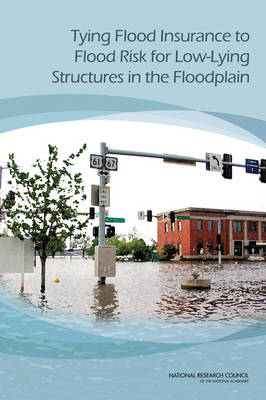
Tying Flood Insurance to Flood Risk for Low-Lying Structures in the Floodplain
Seiten
2015
National Academies Press (Verlag)
978-0-309-37166-7 (ISBN)
National Academies Press (Verlag)
978-0-309-37166-7 (ISBN)
Floods take a heavy toll on society, costing lives, damaging buildings and property, disrupting livelihoods, and sometimes necessitating federal disaster relief, which has risen to record levels in recent years. The National Flood Insurance Program (NFIP) was created in 1968 to reduce the flood risk to individuals and their reliance on federal disaster relief by making federal flood insurance available to residents and businesses if their community adopted floodplain management ordinances and minimum standards for new construction in flood prone areas. Insurance rates for structures built after a flood plain map was adopted by the community were intended to reflect the actual risk of flooding, taking into account the likelihood of inundation, the elevation of the structure, and the relationship of inundation to damage to the structure. Today, rates are subsidized for one-fifth of the NFIP's 5.5 million policies. Most of these structures are negatively elevated, that is, the elevation of the lowest floor is lower than the NFIP construction standard. Compared to structures built above the base flood elevation, negatively elevated structures are more likely to incur a loss because they are inundated more frequently, and the depths and durations of inundation are greater.
Tying Flood Insurance to Flood Risk for Low-Lying Structures in the Floodplain studies the pricing of negatively elevated structures in the NFIP. This report review current NFIP methods for calculating risk-based premiums for these structures, including risk analysis, flood maps, and engineering data. The report then evaluates alternative approaches for calculating risk-based premiums and discusses engineering hydrologic and property assessment data needs to implement full risk-based premiums. The findings and conclusions of this report will help to improve the accuracy and precision of loss estimates for negatively elevated structures, which in turn will increase the credibility, fairness, and transparency of premiums for policyholders.
Table of Contents
Front Matter
Summary
1 The National Flood Insurance Program and the Need for Accurate Rates
2 NFIP Procedures for Analyzing Flood Hazard and Calculating Insurance Rates
3 Methods for Assessing Flood Risk
4 Factors That Affect Risk-Based Premiums for Negatively Elevated Structures
5 Alternative Approaches and Implementation
References
Appendix A: Biographical Sketches of Committee Members
Appendix B: Glossary
Appendix C: Acronyms and Abbreviations
Tying Flood Insurance to Flood Risk for Low-Lying Structures in the Floodplain studies the pricing of negatively elevated structures in the NFIP. This report review current NFIP methods for calculating risk-based premiums for these structures, including risk analysis, flood maps, and engineering data. The report then evaluates alternative approaches for calculating risk-based premiums and discusses engineering hydrologic and property assessment data needs to implement full risk-based premiums. The findings and conclusions of this report will help to improve the accuracy and precision of loss estimates for negatively elevated structures, which in turn will increase the credibility, fairness, and transparency of premiums for policyholders.
Table of Contents
Front Matter
Summary
1 The National Flood Insurance Program and the Need for Accurate Rates
2 NFIP Procedures for Analyzing Flood Hazard and Calculating Insurance Rates
3 Methods for Assessing Flood Risk
4 Factors That Affect Risk-Based Premiums for Negatively Elevated Structures
5 Alternative Approaches and Implementation
References
Appendix A: Biographical Sketches of Committee Members
Appendix B: Glossary
Appendix C: Acronyms and Abbreviations
1 Front Matter; 2 Summary; 3 1 The National Flood Insurance Program and the Need for Accurate Rates; 4 2 NFIP Procedures for Analyzing Flood Hazard and Calculating Insurance Rates; 5 3 Methods for Assessing Flood Risk; 6 4 Factors That Affect Risk-Based Premiums for Negatively Elevated Structures; 7 5 Alternative Approaches and Implementation; 8 References; 9 Appendix A: Biographical Sketches of Committee Members; 10 Appendix B: Glossary; 11 Appendix C: Acronyms and Abbreviations
| Verlagsort | Washington |
|---|---|
| Sprache | englisch |
| Maße | 216 x 279 mm |
| Themenwelt | Mathematik / Informatik ► Mathematik |
| Naturwissenschaften ► Biologie ► Ökologie / Naturschutz | |
| Betriebswirtschaft / Management ► Spezielle Betriebswirtschaftslehre ► Versicherungsbetriebslehre | |
| ISBN-10 | 0-309-37166-X / 030937166X |
| ISBN-13 | 978-0-309-37166-7 / 9780309371667 |
| Zustand | Neuware |
| Haben Sie eine Frage zum Produkt? |
Mehr entdecken
aus dem Bereich
aus dem Bereich
Bedarfsanalyse, Vertrags-Check, Testsieger für jede Situation, …
Buch | Softcover (2024)
Stiftung Warentest (Verlag)
15,00 €


